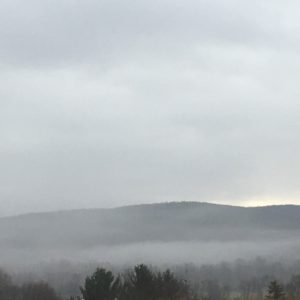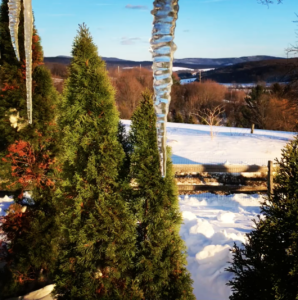There is something that happens with the light around the time of the equinox, when the angle and distance between sun and earth produce exceptionally stunning, crisp stark reliefs of light and shadow.
A week or so ago, driving north along the glacial ridge that borders this part of New York and Massachusetts, the light ahead of an approaching snow squall caught my breath. To the north, really dark clouds, black, nearly, with bright sunlight from a late afternoon sun bouncing off and illuminating stark tree outlines and bright bleached bark in a lovely chiaroscura.
Light and dark, black and white, no soft edges here as the squall blew in and the gorgeous contrasts were replaced by what seemed early nightfall and whiteout conditions. It was a mini blizzard, ahead of the real one we’d get soon enough.

We love contrast, we crave the black and the white, we want things to be clear. Clarity, clairvoyance, seeing clearly. We would like to walk the world as if our vision were as clear and bright as the pre-equinox sun glancing off the beech and sycamore. But the reality is more like perpetual fog, and the longed for moments when it lifts are all too rare, where we break through, the light hits just, so, and everything seems truly clear.
These moments serve as beacons, when our vision pretty much otherwise ranges from zero to minimal. People, events, moments of grace may offer intense flashes of illumination along the way, showing us the path– just long enough to know have we gotten lost, are we still on it, is there in fact a path?– until the light dims and we are back in the fog.

Soon after the squall episode, the local PBS station was running a special on the making of Hamilton. This was a great piece of television, what of it I caught, about a show I have long wanted to see. At one point, referencing Hamilton’s approach to politics, and perhaps life, someone quotes Obama as saying that the only way stuff gets done is when you hear, see the truth of the person sitting across the table from you. This sounds like a truism, like, right, I know that. But the reality of it, the practice of it, is infinitely delicate, complicated, and labor intensive.
In graduate school, as a 20th-century French scholar working on literature of the post-war period, I spent time tangling with theories of the Other. Following a strong start early on by the Germans in the late 18th and 19th centuries, in the last century the French really took hold in the field, with philosophers, psychoanalysts, and theorists like Derrida, Lévinas, Foucault, Lacan, Kristeva; even Sartre and de Beauvoir.
Outside of the Academy, the connections between literature, literary theory, philosophy and psychoanalysis may seem perplexing at best, but given events of the 20th century we needed every tool at our disposal to simply read and absorb much less decipher and possibly interpret.
My field involved literature of the Holocaust. The horror of the Holocaust was for me just about the most extreme schism between all concepts of self and other, the ultimate otherization; I think to some extent I sought answers in the complex, dense, often puzzle-like language of many theorists, but really only found more questions.
That was ok. The seeking itself is of value, of course, and if nothing else I learned that history is not so teleologic and neither are individual lives. Rather than terrifying, that seems an oddly comforting notion when one is engaged in the day-to-day, hand-to-hand work of living. Doing the very best you can may only lead you back to where you began, but that is ok. It may in fact be all about the journey, after all.
On we go, making our way through the fog. The moments of beautiful illuminating chiaroscura are just behind, or ahead; it’s for us to allow the intermediary beacons to shine on the better angels of our own, and others’, natures.
